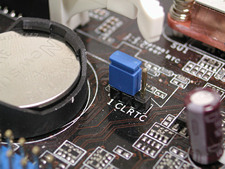Common BIOS problems
How to fix a fast Windows clock and date problems
BIOS Clock problem
If the clock in Windows is fast, try resetting the BIOS to its default settings, because Windows takes its time from the BIOS clock. Doing that often fixes the problem. A fast clock can be a nuisance if you use a PC with a TV tuner card and schedule it to record TV programmes. The BIOS has programming in it that manages the clock’s operation.
When the BIOS date is wrong – set beyond its range – Windows 7/8.1/10 won’t install for the first time
If The BIOS has a date range – say, 2000 to 2999 – and for some reason the date is set to, say, 3000, Windows won’t install on a new build. The following video explores this problem. You just have to enter the correct date into the BIOS, save and exit to fix the problem.
LIVE – Customer Built a New PC That Won’t Work! An eye-opening diagnostic! –
I need to replace the motherboard’s BIOS battery, but I don’t want to reset my customised settings
Question
I need to replace my motherboard’s BIOS battery, but I don’t want to have to reset my customised settings, so can anyone recommend a program that will save the settings so I can restore them after I replace the battery?
Answer
The flash utility that can be used to reflash a BIOS, if its motherboard manufacturer provides one from its website, can usually save the old BIOS file so that it can be restored if reflashing the BIOS causes a problem. You can obtain it with the latest BIOS update for a make and model of motherboard from the motherboard manufacturer’s site.
Some motherboard manufacturers provide a utility that can save, manage and update the BIOS. Here is one form Asus that has to be used with an Asus motherboard. Have a look on asus.com to find out if there is a more recent update, because this one from Major Geeks is dated June 19, 2011. It might work with a UEFI BIOS because this is what the listing says: Requires: Win 8 / Win 7 / Vista/ XP. When installed on a new brand-name OEM PC, Windows 8 uses a UEFI BIOS.
http://www.majorgeeks.com/files/details/asus_update_utility.html
You could also take digital photos of each of the BIOS pages to save the customised settings. This is the easiest and safest way. You shouldn’t mess around with the BIOS unnecessarily, because if it gets corrupted, the PC will be rendered unbootable and if the BIOS can’t be recovered by reflashing it or installing a new BIOS chip, a new motherboard would be required.
BIOS CMOS checksum error on startup
Problem
Three days ago, the following error message started presenting itself whenever I switch on my desktop PC: “CMOS checksum error – Defaults loaded. Press F1 to continue, Del to enter Setup”. When I press F1, the PC starts up as usual, but the clock shows 0.00, and in the Control Panel’s Date & Time, the date is always January 1 2003.
Answer
It looks as if you have to replace the BIOS battery that powers the CMOS chip that contains the clock’s settings. The chip stores the BIOS settings in the same way that a mobile phone stores its settings. If you remove the battery in a mobile phone or it runs out of charge, the settings are lost. The chip also stores the customised BIOS settings, so the computer has to load the default settings, which are hard-coded into it so that they are always accessible to the startup process – even when the BIOS battery is flat.
The image below shows a BIOS battery installed in its socket on the motherboard with the blue jumper covering the two pins that keep the BIOS working normally. The BIOS battery is rechargeable, recharging while the computer runs. After four or five years, it stops taking a charge and has to be replaced. If the PC hasn’t been used for a few weeks or months, the battery may still be working but may just have run down. Leaving the PC on for a day should recharge it.
Most of the motherboards of desktop PCs currently in use have a jumper that clears the CMOS settings when it shorts two specific pins, the blue object in the centre of the image below that also shows the BIOS/CMOS battery in its container on the left of the jumper.

The motherboard’s manual shows the jumper’s location on the motherboard. You can identify the motherboard’s make/model with a utility such as CPU-Z and then locate its manufacturer’s site with a search engine. The motherboard manufacturer’s site should provide a manual for that model. The jumper is near the BIOS battery and is often labelled as such.
If that jumper is left in the ‘clear’ position or is missing, the computer will produce that checksum error message.
Brand new motherboards can have the jumper set to clear the BIOS in order not to run the battery down. Many people don’t bother reading the manual and so are not made aware of that fact.